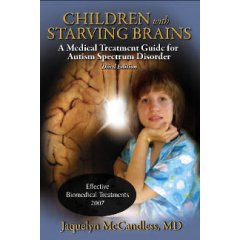''Children
with starving brains''
par Jaquelyn McCandless, MD

Pour le lien vers Amazon,
cliquer ici
Extrait du chapître 9
Hyperbaric Therapy
Many of the greatest discoveries in science and medicine have been found by accident. So it was with methylcobalamin and autism. So it is with hyperbaric oxygen therapy and autism.
Hyperbaric oxygen therapy is classically defined as the inhalation of 100% oxygen at greater than 1 atmosphere absolute (ATA) in a pressurized chamber. This definition is now popularly defined as the inhalation of varying degrees of oxygen at greater than 1 atmo­sphere absolute (ATA) in a pressurized chamber. You will hear many terms used interchangeably by lay people and professionals alike: hy­perbaric oxygen therapy (HBOT), mild hyperbaric oxygen therapy (mHBOT), hyperbaric therapy (HBT), hyperbaric oxygen (HBO), hyperbaric air therapy (HBAT), hyperbaric enriched air therapy (HBEAT), etc. However, the most common way the term is used by the autism community is to just say "HBOT". Then most parents will state what they are doing, e.g. "we're using 1.5, 1.75, or 2.0 atmospheres in a hard chamber with 100% oxygen, or we're using a soft chamber (also referred to as a mild chamber) at 1.3 atmospheres 'with or without a mask' to which 'concentrated oxygen' is be supplied at concentrations varying from 24% to 70%." Conventional wisdom states that unless one receives HBOT in a hard chamber with 100% oxygen at atmospheric pressures greater than 1.5 ATA, little or no benefit will be seen and if parents use a soft chamber with lower pressures and lower oxygen concentrations, they are just wasting their money and cheating their children. However, as his­tory has shown repeatedly throughout the years, convention is only convention until challenged, proven wrong, and then changed. Such is the case with HBOT and autism! Based on the soon-to-be published studies by Dr. Rossignol, the early work of Dr. Buckley and Dr. Kartzinel, and the tremendous number of children that have been treated by physicians such as Dr. Bradstreet, Dr. Feingold, Dr. Freedenfeld, Dr. Stoller and myself, and a growing number of oth­er physicians who are now using HBOT routinely in their offices, there remains no doubt that HBOT works and that it works well for children with autism. There is also no doubt that it works well at low pressures with varying degrees of oxygen concentrations as well as at varying degrees of high pressures with 100% oxygen. As shown from Rossignol's study, high pressure and low pressure treatments both respond about equally well but high pressure treatments and low pressure treatments may each do better to improve different types of symptoms. It is my opinion that this early research, when considered alongside the three general mechanisms of action I will propose later on in this paper, suggests that most children may need treatment at high and low pressures with varying oxygen concentrations in order to receive the maximum cumulative benefit.